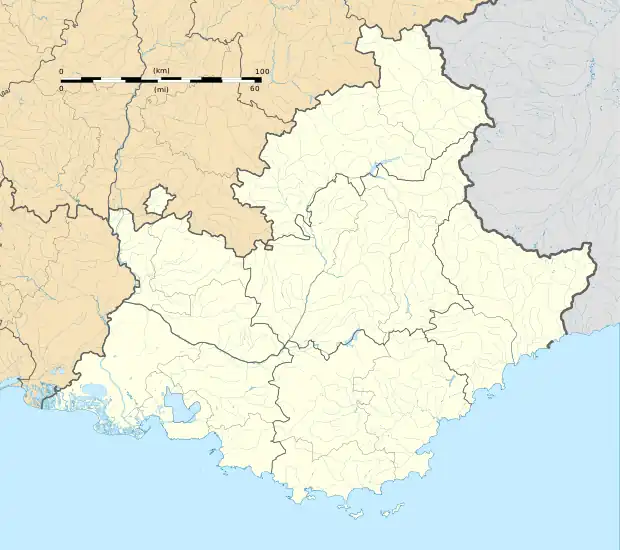Céreste-en-Luberon | |
|---|---|
 The village of Céreste-en-Luberon | |
 Coat of arms | |
Location of Céreste-en-Luberon | |
 Céreste-en-Luberon  Céreste-en-Luberon | |
| Coordinates: 43°51′24″N 5°35′16″E / 43.8567°N 5.5878°E | |
| Country | France |
| Region | Provence-Alpes-Côte d'Azur |
| Department | Alpes-de-Haute-Provence |
| Arrondissement | Forcalquier |
| Canton | Reillanne |
| Government | |
| • Mayor (2020–2026) | Gérard Baumel[1] |
| Area 1 | 32.54 km2 (12.56 sq mi) |
| Population | 1,194 |
| • Density | 37/km2 (95/sq mi) |
| Time zone | UTC+01:00 (CET) |
| • Summer (DST) | UTC+02:00 (CEST) |
| INSEE/Postal code | 04045 /04280 |
| Elevation | 323–971 m (1,060–3,186 ft) (avg. 370 m or 1,210 ft) |
| 1 French Land Register data, which excludes lakes, ponds, glaciers > 1 km2 (0.386 sq mi or 247 acres) and river estuaries. | |
Céreste-en-Luberon (French pronunciation: [seʁɛst ɑ̃ lyb(ə)ʁɔ̃; -lybeʁɔ̃], literally Céreste in Luberon; before 2024: Céreste;[3] Occitan: Ceirèsta) is a commune in the Alpes-de-Haute-Provence department in southeastern France. It is known for its rich fossil beds in fine layers of "Calcaire de Campagne Calavon" limestone, which are now protected by the Parc naturel régional du Luberon and the Réserve naturelle géologique du Luberon.
Geography
The river Calavon forms the commune's northern and northwestern borders.
History
A Gallo-Roman period settlement was established in the quarter of today's Saint-Sauveur priory, possibly as a crossing control point for the river.[4] Surviving relics of the Roman period include a potters' oven, an ancient tomb and Sarcophagi at Saint-Sauveur.
The Priory of Carluc was founded in the eleventh century. Another priory, that of Saint-Sauveur-Au-Pont, belonged during the twelfth and thirteenth century to the Abbey of Saint Andrew at Villeneuve-lès-Avignon. The fiefdom was held initially by the Forcalquiers, and later by the Brancas family.
By the start of the eighteenth century, the Estieu brothers were running a pottery oven.[5]
During the French Revolution the commune had its own Patriotic Society, a variation on the Jacobin Club theme, created in this case soon after 1792.[6]
Population
| Year | Pop. | ±% p.a. |
|---|---|---|
| 1968 | 757 | — |
| 1975 | 832 | +1.36% |
| 1982 | 862 | +0.51% |
| 1990 | 950 | +1.22% |
| 1999 | 1,036 | +0.97% |
| 2009 | 1,220 | +1.65% |
| 2014 | 1,194 | −0.43% |
| 2020 | 1,198 | +0.06% |
| Source: INSEE[7] | ||
See also
References
- ↑ "Répertoire national des élus: les maires". data.gouv.fr, Plateforme ouverte des données publiques françaises (in French). 2 December 2020.
- ↑ "Populations légales 2021". The National Institute of Statistics and Economic Studies. 28 December 2023.
- ↑ Décret No. 2023-959 du 18 octobre 2023 portant changement du nom de communes
- ↑ Raymond Collier, Haute-Provence, pp. 18 and 24-25. See also Gallia XXV, 1967, 2, p. 386.
- ↑ Collier, p. 511.
- ↑ Patrice Alphand, "Les Sociétés populaires", La Révolution dans les Basses-Alpes, Annales de Haute-Provence, bulletin de la société scientifique et littéraire des Alpes-de-Haute-Provence, no. 307, 1989, pp. 296-298
- ↑ Population en historique depuis 1968, INSEE